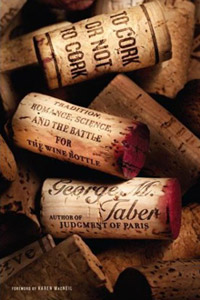 As you might be able to tell from the full title of “To Cork or Not To Cork: Tradition, Romance, Science, and the Battle for the Wine Bottle,”
As you might be able to tell from the full title of “To Cork or Not To Cork: Tradition, Romance, Science, and the Battle for the Wine Bottle,” author George Taber is a wine guy.
He happens to have been the Time magazine correspondent who attended the 1976 event that turned out to be known as “Judgment of Paris.” If he hadn’t been there the results wouldn’t have been as widely known and the ascension of American wine might have been delayed. Just a couple of years ago he wrote a thoroughly entertaining book about the tasting, appropriately titled “Judgment of Paris: California vs. France and the Historic 1976 Paris Tasting That Revolutionized Wine.”
So why would beer drinkers find this book interesting?
First, we’re enjoying more beers from bottles sealed with corks. The wine industry estimates that between 3 percent and 10 percent of corks suffer from “taint,” exuding musty aromas that at all but the lowest levels begin to ruin flavor. TCA (2,4,6-trichloroanisole) doesn’t discriminate. It will happily muck up the flavor of beer as well as wine.
Taber writes, “In the entire world, only a few sounds bring joy to all but the most jaded. One is the purring of a kitten. Another is the thwack of a well-pitched baseball hitting a perfectly swung bat. And the third is the pop of a cork being pulled from a bottle of wine.”
If you’d be inclined to substitute the word “beer” in that last sentence, then you may have already felt the pain of opening a 1985 Jereboam of Chimay Grand Reserve to discover a distinct impression of “wet dog” that can even make beer undrinkable.
Second, Taber has an eye for interesting detail and knows how to tell a story. His passion shows in his research, whether it is the history of cork growing and production or the search for alternatives closures, and his journalistic training in the way he explains all this.
“To Cork or Not To Cork” also examines the balance between art and science, commerce and tradition, romance and just-plain-snobbery. All in the context of wine, of course, but these topics are just as relevant to Beer, Not the Commodity.
Taber writes there is much more for wine scientists to consider and for wine consumers to learn. There certainly are analogies here with beer, although in this case we’re not talking about bottle closures.
For instance, before starting research on “Brew Like a Monk” I asked brewers what sort of questions they’d like to see answered. “Fermenter geometry” was at the top of many lists. Turns out that most of the research on fermenter geometry, like most brewing research, has focused on the production of lagers in large vessels. No surprise since those beers account for more than 90 percent of beer sold.
As a more brewers produce more beers of a different ilk scientists will have reason to analyze what they are doing. The question of “to cork or not to cork” likely won’t inspire the extreme positions taken by some in this debate, but perhaps there will be another one that does.